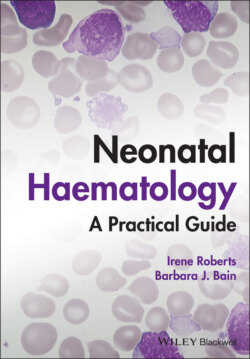Читать книгу Neonatal Haematology - Barbara J. Bain, Irene Roberts - Страница 39
Practical problems in interpreting neonatal blood counts and films Sample quality/artefacts
ОглавлениеOne of the commonest practical difficulties in interpreting neonatal blood counts and blood films occurs because of the much higher haematocrit in neonates. First, there is a higher frequency of clotted samples, which most likely reflects the challenge of collecting free‐flowing blood samples from neonates, especially those who are very low birthweight and/or preterm. Secondly, the high haematocrit often leads to poor‐quality ‘thick’ or unevenly spread films, which may give the misleading impression of the presence of abnormal red cells, such as spherocytes or target cells, which are not seen when the correctly spread section of the film is reviewed (Fig. 1.18). These effects can often be mitigated by dilution of the sample prior to analysis and preparation of the blood film. Another practical problem is the difficulty of distinguishing the typical changes seen on aged blood samples anticoagulated with ethylene diaminetetra‐acetic acid (EDTA) from the normal red cell features typical of preterm babies. It is therefore particularly important to make blood films on neonatal samples as soon as possible.
Fig. 1.18 Blood film of a healthy term neonate with a normal blood count and no evidence of haemolysis, showing artefactual changes in red cell morphology apparent on different sections of the blood film. (a) Thin end of the blood film showing apparent ‘spherocytes’ that are not present on the well‐spread section of the film (compare with Fig. 1.18c). A normal neutrophil, monocyte and NRBC can also be seen. (b) Thick end of the same blood film showing overlapping red cells, which make it difficult to interpret the red cell morphology, and apparent target cells and hypochromia that are not present on the well‐spread section of the film (compare with Fig. 1.18c). Normal neutrophils and an NRBC are also shown. (c) Good section of the blood film showing normal red cell morphology. Normal white blood cells are also shown. MGG, ×40.
